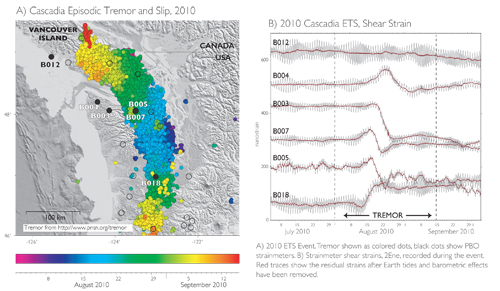Measurements of Slow Slip Phenomena
in Cascadia and Parkfield
Recorded by Plate Boundary Observatory Strainmeters
By:
Kathleen Hodgkinson
UNAVCO
Click for a Live Broadcast.

Abstract
The Plate Boundary Observatory (PBO), operated by UNAVCO, is the geodetic component of the NSF funded Earthscope program. Its purpose is to record the full spectrum of deformation processes that accommodate strain accumulation and release across the Pacific-North American plate boundary in the western US.
Enabling investigation of the role aseismic strain transients play in plate boundary deformation was one of the stated goals of PBO and to accomplish this, strainmeters were included in the observatory. Their role is to capture transients the size and duration of which would render them undetectable by GPS and seismology.
Between June 2005 and October 2008 75 borehole and 6 long-baseline laser strainmeters were installed in targeted regions with specific questions in mind, e.g., Episodic Tremor and Slip (ETS) events in Cascadia, slow slip events along the Parkfield and San Juan Bautista segments of the San Andreas and strain accumulation in the Anza seismic gap near the San Jacinto fault.
Four were installed on Mt St Helens and five in Yellowstone for volcano deformation studies. Since completion of the network PBO strainmeters have provided unprecedented temporal resolution of strain pulses that evolve over minutes, e.g., nanostrain-level creep events on the central San Andreas, out to measurements of transients on the order of a 100 nanostrain over weeks during Episodic Tremor and Slip events along the Cascadia Subduction Zone.
PBO boreholes are multi-instrumented sites containing combinations of strainmeters, seismometers, pore pressure sensors, and meteorological instrumentation. Volcanic sites also include tiltmeters. Raw data are available to the research community in SEED format from IRIS; processed data are available from UNAVCO within 24 hours. As of April 2015 more than 1 TB of PBO BSM raw data and products have been delivered to users and strainmeter data products have been downloaded by more than 1,400 unique users. This presentation will include details of installing and operating the PBO strainmeter network, the steps required to process and isolate tectonic transients and highlight some of the unique signals these instruments have recorded particularly in Cascadia and Parkfield over the past 10 years.




